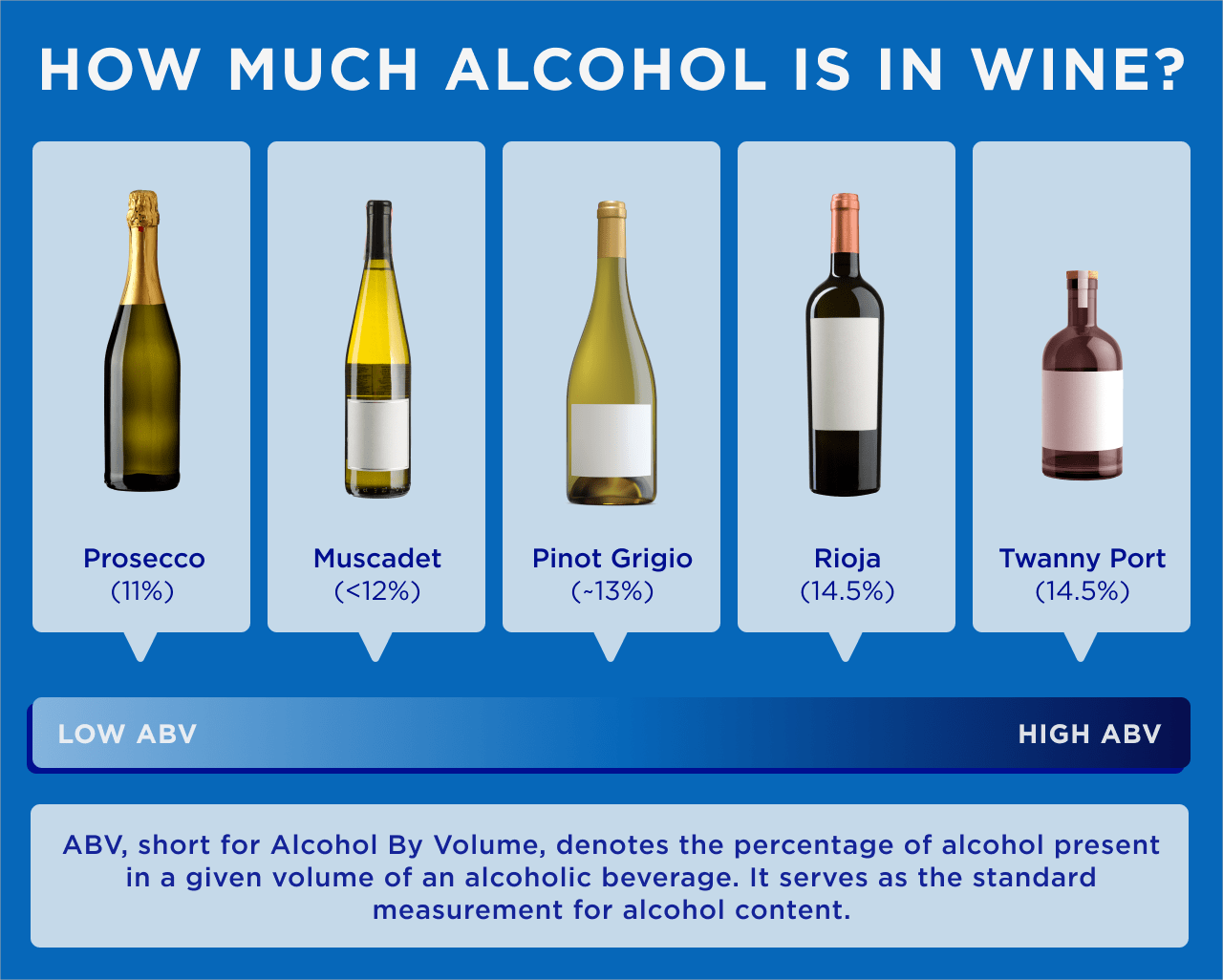How Much Alcohol is in Wine?
Alcohol content isn’t just how boozy a wine is; it plays a critical role in taste and structure.
How much alcohol is in a glass of wine depends on a few factors, including how the wine is made, the type of grapes, and whether or not the winemaker has added sugar or liquor (in the case of fortified wines).
In this article, we’re addressing what exactly ABV is and how much alcohol is in several popular types of wine.

What is ABV?
ABV, short for Alcohol by Volume, denotes the percentage of alcohol present in a given volume of an alcoholic beverage. It serves as the standard measurement for alcohol content.
If you notice a warm sensation on your palate, your wine most likely has a higher ABV, while lower ABV wine will taste lighter, smoother, less structured, and closer to regular juice.
Let’s look at the average alcohol content in most wines.
Average Alcohol Content of Wine
The average alcohol content of wine typically falls within 11-13% ABV, varying depending on the wine variety. Red wines often exhibit a higher ABV than white wines, mainly due to their elevated tannin levels (the astringent taste on your palate).
Here's a breakdown of wine alcohol percentages, categorized from low to high:
- Low-alcohol wines: These wines boast an ABV of 10% or less. Examples include Sweet Riesling (9%), Muscadet (9.5%), Lambrusco (8%), and Moscato d’Asti (5.5%).
- Medium alcohol wines: Falling around 11% ABV, like Pinot Grigio, Pinot Noir, and Champagne.
- High-alcohol wines: Any wine exceeding 13% ABV. Look to Syrah (15%), Zinfandel (14-16%), Marsala (20%), and Port (20% and above).
Now that we know what lower and higher ABV wines are, let’s explore where these levels come from.
Where Does a Wine’s Alcohol Come From?
Alcohol levels come from three primary sources:
-
1. Fermentation Process
As the grape juice (or must) ferments over a designated period, natural yeast or yeast introduced by the winemaker transforms the grapes’ residual sugars into alcohol. The more sugar a grape has, the higher the ABV will be.
-
2. Addition of Alcohol
Spirits like Brandy are added to fortified dessert wines like Port during production. This not only makes for a strong wine, but it adds body and structure.
-
3. Climate
Grapes grown in hotter climates produce more sugars, leading to a higher ABV during winemaking. Cooler climate varietals tend to have less sugar and a lower ABV.

Red Wine Alcohol Content
In the case of dry red wines, just about all of the grapes’ natural sugars are converted into alcohol during winemaking. The stems, seeds, and skins are soaked in the must for an extended period of time, adding structure and color.
Below is a list of famous red wines by alcohol content from low to high.
- French Bordeaux: Moderate, 12.5-13.5%
- Italian Chianti: Moderate, 12.5-13.5%
- Spanish Rioja: Moderate: 12.5-13.5%
- Argentine Malbec: High, 13.5-14.5%
- Australian Shiraz: High, 13.5-14.5%
- California Cabernet Sauvignon: High, 13.5-14.5%
- California Pinot Noir: High, 13.5-14.5%
- Chilean Merlot: High, 13.5-14.5%
- California Petite Sirah: Very high, more than 14.5%
- California Zinfandel: Very high, more than 14.5%
- Port: Very high, more than 14.5%
White Wine Alcohol Content
White wine grapes aren’t soaked in the skins like red wine during winemaking. This results in a light yellow, gold, or even clear color. On average, white wines are usually lighter than red wine, with a lower ABV.
Below are some white wines with lower to higher alcohol content.
- French Muscadet: Very low, under 12%
- German Riesling: Very low, under 12.5%
- Portuguese Vinho Verde: Very low, under 12.5%
- Austrian Grüner Veltliner: Moderately low, 12.5-13.5%
- Australian Riesling: Moderately low, 12.5-13.5%
- French White Bordeaux: Moderately low, 12.5-13.5%
- French White Burgundy: Moderately low, 12.5-13.5%
- Italian Pinot Grigio: Moderately low, 12.5-13.5%
- New Zealand Sauvignon Blanc: Moderately low, 12.5-13.5%
- Chardonnay: High, 13.5-14.5%
- Madeira: Very high, more than 14.5%
- Sherry: Very high, more than 14.5%
Sparkling Wine Alcohol Content
Sparkling wines like Champagne often undergo a double fermentation in the bottle, resulting in carbonation. These wines also contain lower ABVs on average due to their light and crisp nature.
Below is the alcohol content for a few popular types of sparkling wine.
- Prosecco: Very low, under 11%
- French Champagne alcohol content: Moderately low, 11-13.5%
- California Champagne: Moderately low, 12.5-13.5%
- Spanish Cava: Moderately low, 12.5-13.5%
Highest ABV Wine
When it comes to alcohol consumption, the wines with the highest ABV are, without a doubt, fortified wines, also known as dessert wines, which can have as much as 100 grams of sugar per bottle. During winemaking, distilled spirits are added to these wines, resulting in an incredibly high ABV.
Aged Ports, also known as Tawny Port, have some of the highest ABVs, around 20-30%.
Check the Label for ABV
If you’re curious about how much alcohol is in your bottle of wine, check the label. Remember, anything below 11% is on the lower side, while wines above 12-13% are more boozy.
If you’d like to enrich your wine knowledge further, check out our Podcast and Wine Online 101 for everything related to the world of wine.
As a leader in the alcohol e-commerce and the wine industry, we can’t wait to share our expert knowledge with you.
